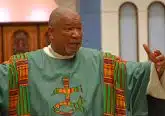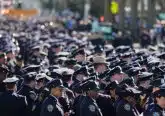George Floyd’s death shows need for ‘sanctity of life’ police training, researcher says
by Jonah McKeown
Washington D.C., Jun 7, 2020 / 03:54 pm MT (CNA).- A researcher who studies policing best practices told CNA this week that George Floyd’s arrest and death in Minneapolis reaffirm the need for de-escalation training and, ultimately, a culture of policing that recognizes “the sanctity of all human life.”
In the video of the May 25 arrest, an officer with the Minneapolis Police Department can be seen kneeling on Floyd’s neck for several minutes after he was taken into custody. Floyd could be heard saying “I can’t breathe” several times. He died soon after.
The Police Executive Research Forum (PERF)— a Washington D.C.-based independent research and policy organization that studies best practices in policing— in 2016 released a report detailing 30 Guiding Principles on the Use of Force and training guide for police departments.
“Ultimately, this report is about the sanctity of all human life,” the opening line of the report reads.
“It’s so important because it really, in one term, one sentence, really crystallizes what policing is all about: the sanctity of human life, the importance of putting others before yourself, recognizing that even though someone may have committed a crime, they deserve to be treated decently and with respect,” Chuck Wexler, executive director of PERF, told CNA June 4.
The report does not deal with situations where a suspect is using deadly force— such as when a person is shooting at officers or bystanders— in which case, a police officer must act to protect themselves or members of the public.
Instead, it focuses on incidents where a suspect is unarmed, or armed with a weapon other than a gun— what it describes as “incidents where officers do have time to assess the threat and develop a response that best protects everyone, including themselves.”
In the vast majority of these cases, Wexler said, a suspect may be suffering from mental illness, a disability, or may be impaired because of alcohol or drugs.
Though all the details of George Floyd’s arrest are not yet clear, videos of the incident seem to show that Floyd was in some way impaired, Wexler says. He was not armed.
“There was something going on in his life that was altering his behavior,” Wexler observed.
“He looked like he was having trouble standing; he’s definitely impaired in some way…I didn’t see any violent behavior. I didn’t see the necessity of what they did, of having to hold him down.”
No shots were fired during George Floyd’s arrest, but nevertheless, Wexler said he “didn’t see at all the necessity for the force that was used on him.”
“It’s a tragedy. It’s just a tragedy on so many levels,” Wexler commented.
He added that another of their guidelines is “Duty to Intervene.” He explained, “if someone was doing something wrong and there were other officers there, the other officers had a duty to intervene, meaning to try to change what that officer was doing.”
Wexler said in the case of a person behaving erratically, officers should be trained to slow down the situation, keep a safe distance, and above all, communicate as clearly as they can with the suspect.
Wexler himself was inspired, in part, by UK police departments, who usually have to respond to incidents without using deadly force. In Scotland, fewer than 2% of the country’s 17,000 officers are armed.
As part of the process, PERF took 25 police chiefs from the United States to Scotland to learn de-escalation techniques.
Scottish officers have to rely on their communications skills, tactical defense skills, and typically non-lethal equipment such as a baton, chemical spray, and handcuffs.
“They step back, and then they start talking and communicating, because they don’t have a gun. In the United States, if someone pulls out a knife, the first thing a police officer will do was reach for his gun and aim it at the person. There’s a big difference in approach,” he said.
In addition to impairment or mental illness, a suspect may also have other disabilities that officers have not been trained to handle appropriately.
In 2013, a man with Down syndrome named Ethan Saylor died of injuries sustained after three off-duty sheriff deputies forcibly removed him from a Maryland movie theater when he tried to enter without a ticket.
The report recommends that police departments coordinate with local mental health professionals to train officers on how to engage with people with disabilities.
PERF’s 2016 report contains many evidence-based recommendations to reduce the number of people killed by police, and the number of officers killed in the line of duty.
For example, the report recommends a ban on police shooting at moving vehicles unless the suspect is using deadly force from the vehicle— a move which greatly reduced the deaths of both suspects and officers in New York City after it was implemented in 1972. Cities like Boston, Chicago, Cincinnati, Denver, Philadelphia, and Washington D.C. have since adopted similar policies.
In crafting the original report, PERF consulted with hundreds of police chiefs over the course of two years, and looked at countless case studies and reports to put together their findings and then their training program.
PERF also consulted with Cardinal Timothy Dolan of New York— who was at that time the chair of the U.S. bishops’ Committee on Pro-Life Activities— as well as with Cardinal Blase Cupich of Chicago, who lent his support in helping the group’s training programs for the Chicago Police Department.
Wexler said Cardinal Dolan was particularly supportive of the language of “sanctity of life” in the report. Over the years, he said, “I’ve gotten some really wonderful feedback about the sanctity of human life.”
The report emphasized that most officers involved in controversial use-of-force incidents should not be faulted, because their actions reflected the training they received.
One of the biggest problems in changing the culture of policing is the patchwork of 18,000 police departments all across the country, each with its own training for officers.
“There are no national guidelines on de-escalation,” Wexler said.
“When people would say, ‘We want to de-escalate this situation,’ that term hadn’t been defined. What we did is we operationalized that term and we now teach it.”
When PERF first released its guidelines in March 2016, they were met with harsh criticism from both the International Association of Chiefs of Police and the Fraternal Order of Police.
“We cannot reasonably expect law enforcement officers to walk away from potentially dangerous situations and individuals in the hope that those situations resolve themselves without further harm being done,” the organizations said at the time in a joint response to PERF’s initial report.
Wexler said today, after four years, the report’s recommendations are “no longer controversial.”
“Many of the larger agencies have adopted them. The number one guideline, the sanctity of human life guideline, has been embraced by many departments,” he said.
Many U.S. police departments that have already incorporated de-escalation techniques into their training have seen positive results.
The report points to the Seattle police department, whose officers interact with some 10,000 people a year with mental illness and, thanks to their training, very rarely have to resort to force of any kind.
Seattle has a large number of people experiencing homelessness, and Wexler said training that helps officers understand their situation can help to avoid fatal conflicts.
For example, some homeless people sleep with a knife for protection, he said. So if an officer confronts them, their first reaction may be to go for their knife— not to attack the officer, but as a measure of self-defense.
“In those kinds of situations, we ask the police to step back, begin communicating, get cover, get yourself safe. We don’t want any police officers to get hurt,” he said.
In addition, it recommends a prohibition on deadly force on suspects who pose a danger only to themselves; that departments document use of force incidents and report them to the public; and that departments make de-escalation a core theme of their training programs.
Wexler said he hopes police departments will use the various videos from the George Floyd incident to assess what went wrong and determine how such an incident can be prevented in future.
“This unfortunate video in Minneapolis will be a ‘training video,’ in the sense that they will ask officers to look at [the video], and then say, ‘Pick this apart. Tell me what happened here. Tell me what should have happened.’ That’s what’s different today— there’s a sense that we need to learn from these situations,” he said.












